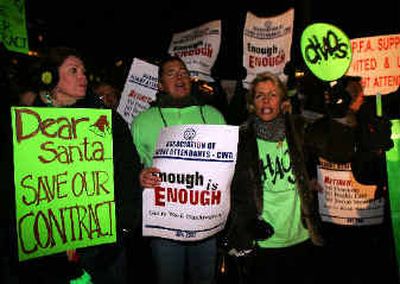Service with a strained smile

Take a pay cut in the neighborhood of 30 percent, give up some vacation time and sick-leave benefits and even lose promised pensions. Then, work longer hours.
This is what tens of thousands of airline workers — mechanics, flight attendants, baggage handlers, counter agents — have been enduring in recent months. It’s hard to imagine how all of this wouldn’t affect customer service.
But so far, the cutbacks in the airline industry haven’t resulted in big problems for passengers. Morale is rock bottom, airline workers say, but they are hustling to keep their companies alive — partly out of pride and partly out of the fear that anything that drives customers away could kill the carrier. Most have kept their bitter battles with management out of the airplane cabin.
UAL Corp.’s United Airlines just last week reached a tentative deal with its pilots that will cut pay 15 percent on top of a 30 percent pay cut last year and terminate a generous pension plan. But it has actually been more punctual this fall than back in the late 1990s, when airlines were flush with cash and workers were protesting for bigger pay raises. ATA Airlines was No. 2 among major carriers in on-time performance in October, the month it filed for bankruptcy reorganization. On-time performance is a good measure of customer service because so many employees can mess up an airline operation. If a catering truck is late — or bag handlers call in sick, or pilots decide to slow planes down — flights are late.
The decent on-time performance bodes well for Christmas travel this week, when heavy traffic is expected to descend on the nation’s airports. There is one notable exception: Service at US Airways Group Inc. has slumped since that airline’s second bankruptcy filing in September, and US Airways’ future is far from certain.
In September and October, according to U.S. Department of Transportation data, US Airways was the worst among major airlines in customer service complaints and second-worst in baggage handling and cancellations. Its on-time standing fell to below-average.
One recurring problem: staffing in Philadelphia. Some employees say sick calls are running high. Customers complain of waiting 45 minutes for luggage to reach carousels and delays waiting for minor maintenance fixes. “It seems like they just don’t have their act together,” says John Vaccaro of Charlotte, N.C., who flies US Airways regularly. “The worst is when you arrive and there’s no one there to meet the plane.” Workers say US Airways laid off so many employees that ground staff has been too thin to get work done promptly.
US Airways says it cut staff too far in 2003, but rectified that. Lately it has been adding workers to keep up with attrition. Philadelphia has seen many employees quitting, some to take security screening jobs that pay $12 an hour — more than some ramp workers now earn. Sick calls are up, the company says, but not to an “extreme” level.
“There have been some operating challenges, but for the most part, our employees have done an outstanding job and not let the pay cuts, etc., become a distraction,” spokesman Chris Chiames says.
Many regular US Airways customers agree that workers have kept a stiff upper lip and delivered good service despite personal pain. “I think it’s better than before,” says Donald Etter, a jewelry wholesaler from Pittsburgh. When one frequent traveler griped about US Airways service recently on flyertalk.com, a road warrior Web site, four others quickly defended US Airways employees.
Travelers need to watch US Airways closely. The company has important financial deadlines coming up in January; it has to raise more money and get workers to agree to more cuts — and do it without running out of cash. (Worst-case scenario: February is about the earliest it could conceivably quit flying.)
Negotiations with mechanics and baggage handlers represented by the International Association of Machinists could be tough. The IAM hasn’t publicly threatened to strike. But it may be hard to get workers to approve a new contract that outsources many of their jobs. A judge can impose a new contract, but workers might fight back. “We want US Airways to continue, but continue with our people working,” IAM spokesman Joe Triberi said.
In general, though, recent rhetoric about possible strikes at some airlines should be of little concern to travelers. Strikes are unlikely right now for a simple reason: Workers know a strike at a bankrupt airline would likely be a death blow for the company.
Of course, airlines can disappoint customers in good times as well as bad. Delays, lost bags and surly employees anger travelers when airlines are making profits — probably even more so when ticket prices are high. And plane parts break down all the time, regardless of airline-penny pinching.
Employees, however, are learning to live with far more tumult. Pilot Matt Blue was hired at US Airways in 1989 and laid off in 1991. He returned in 1998, then laid off again in 2002. After a year living off severance, unemployment insurance and a video-store job, he was hired by one of US Airways’ commuter lines, PSA. He’s earning $48,000 a year, down from $100,000.
Flight attendant George Trkulja is a third-generation Pittsburgh tavern owner who joined US Airways for supplemental income when a nearby steel mill closed 25 years ago.
For a time, he worked only three days a week, but was paid so well that he considered it a full-time salary. No more. “We’re just numb,” he says.
Most employees, he says, are working hard to help the company survive. Some, though, “say if we have 30 percent less pay, they do 30 percent less on the job.”